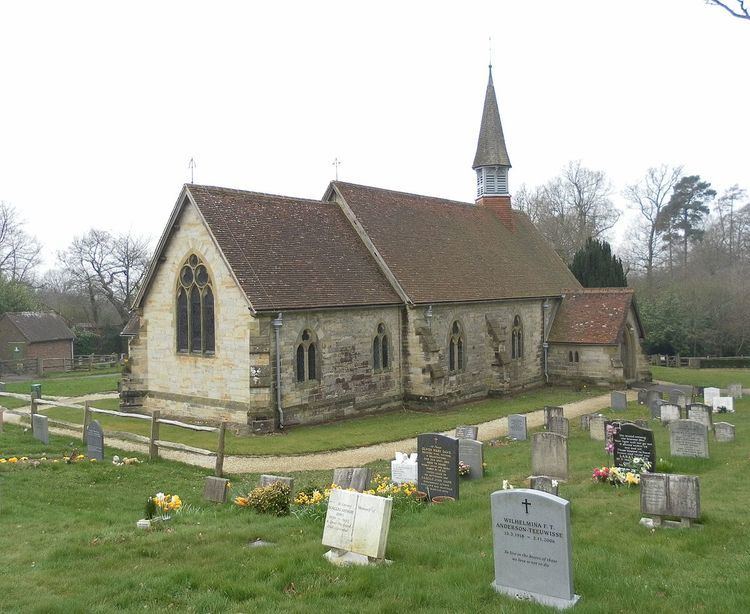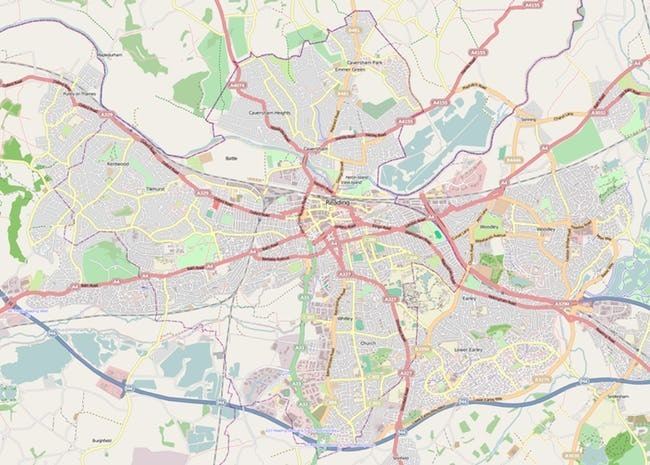Nationality English Name James St | Practice St. Aubyn & Wadling Occupation Architect Role Architect | |
 | ||
Parents Thomas St Aubin, Frances Fleming St John Structures Temple Church, St Enodoc's Church - T, All Saints' Church - Reading, St Michel's Mount, St James' Church - Stretham | ||
James Piers St Aubyn (6 April 1815 – 8 May 1895), often referred to as J P St Aubyn, was an English architect of the Victorian era, known for his church architecture and confident restorations.
Contents
- Early life
- Career
- 1840s
- 1850s
- 1860s
- 1870s
- 1880s
- After 1885 in partnership with Henry J Wadling
- Date unknown
- Church restorations listed by counties chronologically
- References

Early life
St Aubyn was born at Powick Vicarage, Worcestershire, in the English Midlands, the home of his maternal grandfather, on 6 April 1815. He was the second son of the Rev Robert Thomas St Aubyn and his wife, Frances Fleming St John, and a cousin of John St Aubyn, 1st Baron St Levan, of St Michael's Mount, Cornwall. He was known to his family and friends by his second Christian name of Piers (sometimes spelt Pearse). He was educated at Penzance Grammar School before beginning his studies in architecture.
He married Eliza Phillpott in 1852 at Stoke Damerel, Devon. Eliza was born in Ceylon in 1816 and died in 1881 at their home, 108 Cambridge Street, Hanover Square, London.
Career
He was articled to Thomas Fulljames (1808–1874) in Gloucester and acted as clerk of works for the latter's Edwards College, South Cerney (Glos) in 1838–39. He was elected to the Royal Institute of British Architects in 1837, on the nomination of George Basevi, Edward Blore and William Railton, and became a Fellow of the Institute in 1856, proposed by Benjamin Ferrey, Giles Gilbert Scott, and Francis Penrose. He twice served on the Council of the Institute (in 1858–60 and 1870–72). He was Surveyor to the Middle Temple in London from 1851 until 1885, and practised from Lambe Buildings in the Temple for much of his career. From about 1885 onwards, when he seems to have semi-retired, St. Aubyn worked in partnership with Henry John Wadling (d 1918), who entered his office as a pupil in 1858 and remained as his assistant and managing clerk. St Aubyn died on 7 May 1895 at Chy-an-Eglos, Marazion (Cornwall), and is buried on St Michael's Mount. H J Wadling succeeded to his practice, and continued to trade as "St Aubyn & Wadling".
St Aubyn was undoubtedly assisted in developing his career by his family's prominence in Devon and Cornwall, and particularly in Devonport, where they were the major landowners. He practised chiefly in London and developed a practice which extended all over southern England, but he also kept an office in Devonport for part of his career, and he was employed particularly extensively in Devon and Cornwall. Apart from this local connection, there are clusters of his work in Gloucestershire (no doubt deriving from his years in Fulljames' office), Kent, Reading, Cambridgeshire and Leicestershire.
He was primarily a church architect, building a considerable number of new churches and undertaking even more restorations. His church work was firmly in the Gothic revival mainstream of his time, rarely departing from the forms and decoration of the Decorated period, and lacks much originality or flair. His churches at All Saints, Reading and St Mary, Tyndalls Park, Bristol, are notably similar. His restorations often amounted to wholesale or partial rebuilding, and were seen by later generations as unnecessarily brutal; Sir John Betjeman was among St Aubyn's 20th-century detractors. St Aubyn also designed a number of country houses, mostly in a rather cheerless early Gothic style. The one whimsical building he is known to have designed is the clock tower in the grounds of Abberley Hall, c 1883. His greatest professional disappointment was his failure to secure the commission to build Truro Cathedral, which he lost by one vote to John Loughborough Pearson; his designs for the Cathedral were published in Building News, 20 December 1878. His most notable achievement was the restoration of St Michael's Mount, described by Nigel Nicolson as: "among the greatest achievements of 19th-century architecture".
1840s
Berkeley Cottages, Collingwood Road, Stoke Dameral, Plymouth: 1847
1850s
1860s
1870s
1880s
After 1885 in partnership with Henry J Wadling
Date unknown
Church restorations listed by counties chronologically
Bedfordshire: Ampthill, 1877
Buckinghamshire: Weston Turville, 1879; Marsh Gibbon, 1879–80; Maids Moreton, 1882–87; Stone, 1883–90
Cambridgeshire: Soham, 1879–80; Gamlingay, 1880–81; Castle Camps, 1882; Little Abington, 1885; Little Gransden, 1885–88; Teversham, 1888–92
Cornwall: Sennen, 1847; St Agnes, 1848; Godolphin, 1849–51; Mawgan-in-Meneage, 1855; Kenwyn, 1860–62; Lesnewth, 1862–65; Lanivet, 1865; Egloshayle, 1867; St Keyne, 1868–77; Minster, 1869–71; Tintagel, 1870; Hessenford, 1870–71; St Minver, 1870–75; Tuckingmill, 1878–79; St Breock, 1880–82; St Piran's Church, Perranarworthal, 1884; Ludgvan, 1887–88; Mevagissey, 1887–88; Stratton (1888); Werrington (at the time in Devon), 1891; St Germans, 1891–93; Gulval, 1892; Callington, date unknown; St Issey, date unknown; Mabe date unknown (after 1866) Note: St Aubyn's work always included a footscraper outside the porches: John Betjeman knew this and often failed to visit churches where these could be found.
Derbyshire: Duffield, 1846; St Andrew's Church, Cubley, 1872–74
Devon: Stoke Fleming, 1871; Dawlish, 1874; St. Giles-on-the-Heath, 1878
Gloucestershire: Daglingworth, 1845–51; South Cerney, 1861–62; Standish, 1867; Owlpen, 1874–75; Dursley, 1888–89
Hampshire: Sherborne St John, 1854, 1866–84
Herefordshire: Cusop, date unknown
Kent: Cliffe, 1864; Boughton-under-Blean, 1871; Lympne, 1878–80; Harbledown, 1880; Sheldwich, 1888
Leicestershire: Whitwick, 1848–50; Holy Trinity, Ashby-de-la-Zouch, 1866; Ashby Parva, 1866; Appleby Magna, 1870–72; St Helen, Ashby-de-la-Zouch, 1878–80
Lincolnshire: Theddlethorpe All Saints, 1885
Northamptonshire: Maidwell, 1891
Nottinghamshire: Eakring, 1880–81
Suffolk: Little Glemham, 1857–58; Woolverstone, 1888–89; Sternfield, date unknown
Surrey: Addington, 1876
